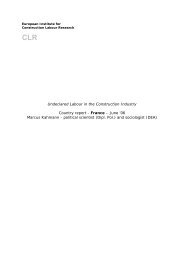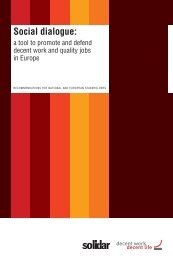Japan – what can we learn? - Construction Labour Research
Japan – what can we learn? - Construction Labour Research
Japan – what can we learn? - Construction Labour Research
You also want an ePaper? Increase the reach of your titles
YUMPU automatically turns print PDFs into web optimized ePapers that Google loves.
time could be up to 50 or more hours a <strong>we</strong>ek. It is not clear whetherthere are signifi<strong>can</strong>t changes according to the season. But astemporary or casual work could be more important than officiallyshown, it is quite possible that workers do not work every day, butonly once in a while as work is offered.As far as I could notice, there is quite a lot of new building work,especially housing, but also renovation of public buildings, civilengineering (street works) and private non-residential building. It isapparent that the level of activity is much higher than in (Western)Europe. It also worth noting that private houses (with in most casestwo stories and 80 to 120 m 2 , on a ground of very often less than100m 2 ; a Tokyo Act says that the ground to build a house on must notbe smaller than 50m 2 ) do not seem to be built for eternity. The qualityboth of the construction itself and the standard of equipment is quitepoor. There is almost no insulation and basic equipment such ascentral heating is almost unknown. Such houses are being rapidlybuilt. First the groundwork with a concrete flooring and necessaryconnections (electricity, water, …) is constructed within a few days to<strong>we</strong>eks, then the building itself is erected and assembled within one totwo <strong>we</strong>eks; the fixing, finishing and interior work then takes anotherfew <strong>we</strong>eks depending on the total size of site and the number ofsections (phases). The roof is normally completed after the erection ofthe wood frame or the wood construction. All the construction is madeof wood, but the inside covering is made of gypsum; the outsidecovering could be made of fibrous material. This ‘lack of quality’ (Iwould call it from the German and/or the European perspective) couldresult from the extremely high costs of land (in and around Kokubunji,Kodaira, or Tachikawa in Tama Area as a part of the metropolitanregion and some 30 to 40 km distance from downtown Tokyo, anaverage plot in an average neighbourhood easily doubles the costs ofthe house). It reduces the importance of the house itself, but also fromthe different cultural access (in combination with different climaticconditions). But I suspect that the most important reason for it is thelack of qualification. Market activity with regard to larger d<strong>we</strong>llings,with very often six to ten or even more stories, is also remarkablyhigh. One <strong>can</strong> see everywhere new buildings under construction orrecently finished. Here not wood, but steel and concrete is the mostCLR News No 2/200611









